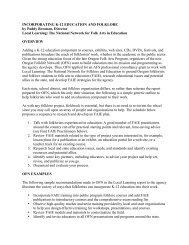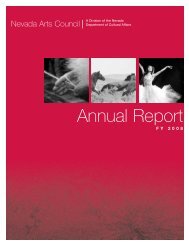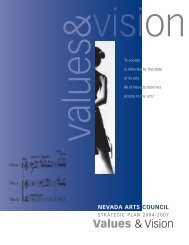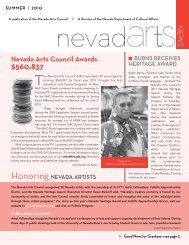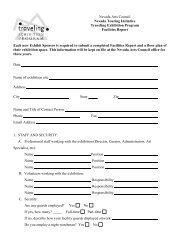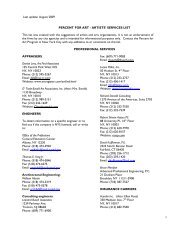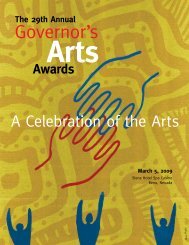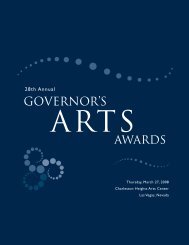WHAT CONTINUES THE DREAM: - Nevada Arts Council
WHAT CONTINUES THE DREAM: - Nevada Arts Council
WHAT CONTINUES THE DREAM: - Nevada Arts Council
You also want an ePaper? Increase the reach of your titles
YUMPU automatically turns print PDFs into web optimized ePapers that Google loves.
oooooooooooooooooooooooooooooooooooooooooooooooooooooooooooooooooooooooooooooooooooooooooooooooooooooooooooooooooooooooooooooooo<br />
Regalia are always unique to the individual dancer and constitute a personal expression of artistry, identity, and creativity. “Powwow” means different things to<br />
different people, even within families or tribes. The significance of the powwow to an individual may be influenced by tribal affiliations, family connections, spiritual<br />
beliefs, personal circumstances, and myriad other factors. Dancers dress in regalia appropriate to specific competitive or social dances, but personalized in ways that<br />
have special meaning to the wearers.<br />
Dance regalia may be homemade or purchased, and may utilize traditional or contemporary materials. Patterns and colors are chosen for personal, family, or tribal<br />
significance. Some dancers wear heirloom pieces that have been passed down in their families. Many make regalia for themselves and family members. Some pieces<br />
are made for sale and purchased locally, at a powwow, or on the internet.<br />
Powwow cannot represent one single “Native American” culture; that does not exist. Powwow represents the blending and mixing of traditions from the many<br />
different tribes and cultures present in North America throughout its history. Powwow is an expression of contemporary living communities, not historical ones.<br />
As such, it reflects intricate and complex relationships between and among people who honor and celebrate their own tribal culture, heritage and identity. Many<br />
different traditions are represented and respected as part of “powwow tradition.”<br />
to show respect…<br />
At the intertribal powwow, all people are welcome to<br />
watch and participate.<br />
If you are enrolled in a recognized tribe, you can have eagle feathers<br />
in your dance regalia. For others, because eagles are endangered<br />
species, it’s against the law to have them. Different tribes have their<br />
own ways, but eagle feathers are often given to people or families by<br />
their tribe, to show respect.<br />
So, at a powwow, you pay respect to a dancer who has eagle feathers<br />
because he’s earned them, like guys who have come back from the<br />
military, from fighting in a war. I was taught to respect the medicine<br />
the eagle provides, and that when you receive feathers, everything of<br />
your being goes into them.<br />
When I was younger, when I danced in my bustle and head roach, my<br />
fan and my dance stick in my hand, before I performed, I tugged on all<br />
my feathers and if there was one that was loose, I’d put it back in my<br />
bag and then go out there. To drop a feather in the arena, after the<br />
grounds have been blessed, I was taught, that’s the most disrespectful<br />
thing you can do as far as eagle is concerned.<br />
Interviewed by Rebecca Snetselaar, May 4, 2010, Henderson, NV.<br />
– John Bear, Choctaw/Apache<br />
Dancers at the 2010<br />
Snow Mountain Powwow.<br />
Photo by Rebecca Snetselaar.<br />
ooooooooooo




